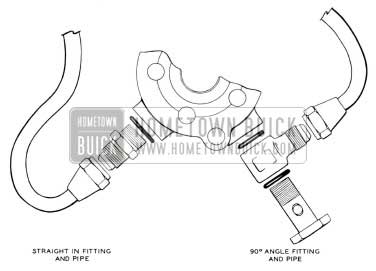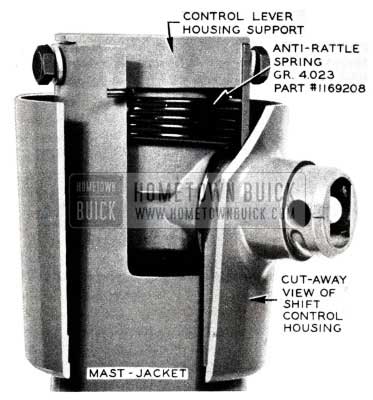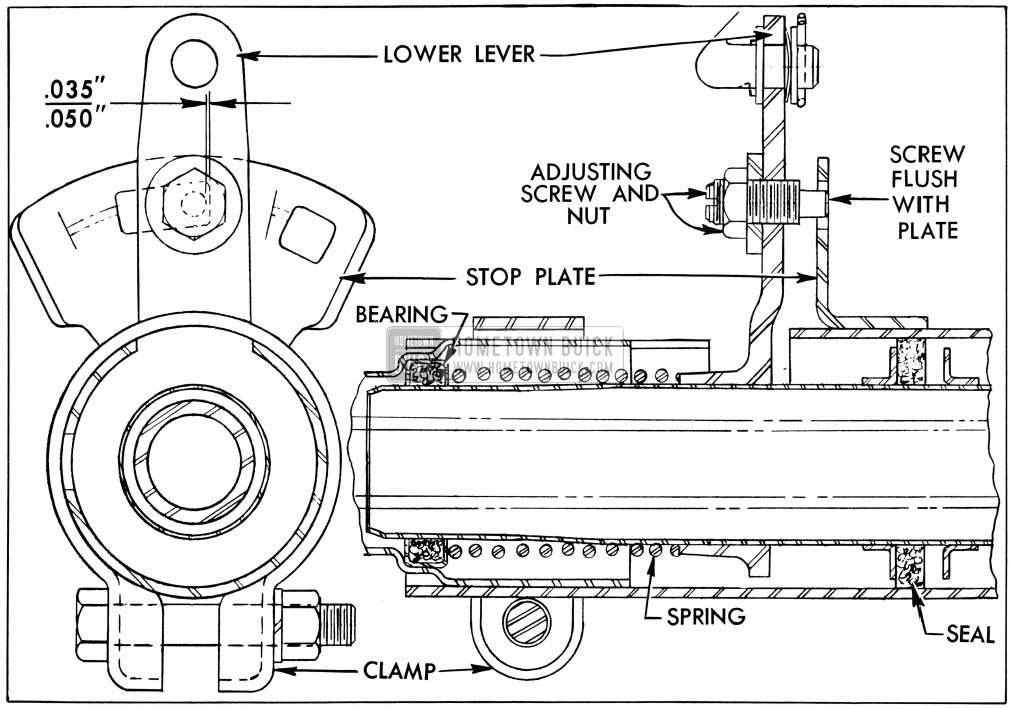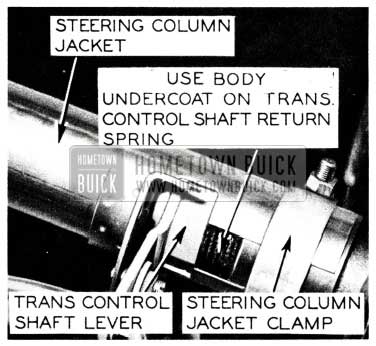HYDRAULIC STEERING GEAR CHANGE
A change has been made in the method of connecting the Hydraulic Steering Gear Valve to Cylinder Tubes at the valve end. The 90° universal fitting elbow and bolt previously used at the valve ends, has been changed to a straight in type fitting (union). See Figure 48.

1955 Buick Hydraulic Steering Gear
This fitting change required the reforming of the tubes by adding a bend to accomodate the straight in type fitting. Since the serial number change points are not available for this change the parts will be described in the parts book as “90° angle Fitting Type” and ”Straight in Fitting Type” and it will be necessary to determine the type of fitting on i:he valve when ordering replacement parts. The new tubes and straight in type fitting (union) will be shown in the May 1st supplement of the current model parts book. The use of the 90° universal fitting and bolt at other locations in the Hydraulic Steering Gear are not affected by this change.
NEW NYLON BEARING
Power Steering Shaft
A new spring loaded nylon steering shaft upper bearing has recently gone into production. This new bearing, Gr. 6.521, Part #1169623, will prevent chucking or rattling noises in the upper part of the steering shaft. Therefore, it is recommended that the new bearing be used as a replacement for the old type fabric bearing Gr. 6.521, Part # 5664839, whenever complaint of steering shaft rattle or chucking noises are encountered.
LOWER MAST JACKET CLAMP DISTORTION
1955
A few cases of the steering gear mast jacket clamps being distorted, when tightening the steering column jacket to steering gear assembly, have been caused by clamp bolt not being torqued properly. To prevent distortion of the clamp, two plain washers should be installed, one under the head of bolt and one between lock washer and clamp.
The bolt should be torqued to 20-30 ft. lbs. otherwise the mast jacket will work upward causl.ng interference between the steering wheel spokes and directional signal lamp housing.
A change is being made in production to incorporate a heavier clamp assembly, thereby eliminating the necessity of using washers.
STEERING COLUMN RATTLES
A few cases have been reported of a rattle in the upper steering column that has been traced to the shift control linkage.
This rattle occurs on rough roads or severe bumps; however, it is not detrimental to safe operation of the vehicle. A anti -rattle spring Gr. 4.023 Part No. 1169208 has been released for service to eliminate any complaints of this type.
Installation of the anti -rattle spring is as follows:
- Remove steering sheel and horn ring using steering wheel puller J -3274 as outlined in 1955 Product School Manual.
- Loosen directional signal wiring at lower steering column and remove switch and housing.
- Remove three bolts from mast jacket to control lever housing support.
- Place control lever in “Park” position then remove control lever.
- Remove support.
- Install spring with large hook end of spring around control lever housing. See Figure 49.

1955 Buick Steering Column Control Lever Housing
NOTE: Some jobs might require removal of die flash on the control lever housing in order to install the spring.
- Install threaded control lever housing support only part way to keep spring in proper alignment.
- Using a screw driver wind spring counter clockwise to hook small loop of spring over edge of – mast jacket opening. See Figure 49.
- Reverse procedure to reassemble.
The flat rate time to R&R the assembly is.08hr.
POWER STEERING OIL
Several reports have been received questioning the type of power steering oil being used in production because it has the appearance of engine oil.
Due to a recent change in supply, the power steering oil used in some assembly plants has a bluish cast similar to same types of motor oils, but it is definitely not motor oil, therefore, do not change this oil. If additional oil is required in the power steering reservoir, the following oils are approved: Special Buick Oil for Dynaflow, available through Buick Parts Warehouses under Gr. 4.101 or Automatic Transmission Fluid, Type A, that has an AQ-ATF number embossed in the lid of the can for identification.
STEERING COLUMN RATTLES SHIFT CONTROL
1955 Models
Investigation reveals that in a number of cases the shift control linkage was improperly adjusted, causing rattles, and in other cases the transmission control shaft return spring had not been coated with underbody sealer as outlined in BPS 2.385.
When the transmission shift lever is placed in Drive position a clearance of .035″ to .050″ should exist between lower lever stop screw and upper edge of large opening in stop plate as shown in Figure 50.

1955 Buick Shift Control Valve Adjustment
If this clearance is less than that specified above then the stop pin is positioned too close to upper edge of stop plate opening, making it more susceptible to rattles. However, since this clearance cannot be readily checked because of location, it may be assured by carefully performing the following adjustment.
- Disconnect lower shift rod clevis from idler and make sure that transmission shift lever is firmly held by detent in “Drive” position.
- With shift control lever on steering column in Drive position, push upward on the lever to hold stop screw in contact with stop plate, then adjust clevis in shift rod so that clevis pin will freely enter clevis and lever.
- Shorten length of rod by turning clevis 2 to 3 turns up on rod, then install clevis pin with anti-rattle washers and tighten clevis lock nut. The number of turns at the clevis provides a specified clearance at the stop pin.
A buzzing noise or rattle could be caused from the control shaft return spring vibrating in resonance with some other force in the car which can easily be detected by moving the transmission control lever toward the steering wheel. If this operation stops the buzzing noise while the lever is raised, it can be reasonably certain that the transmission control shaft return spring is causing the trouble. There are several methods to use in eliminating this noise. However, the easiest is to coat the spring with underbody sealer, using a stiff bristle brush. See Figure 51.

1955 Buick Steering Column Rattles Shift Control

Leave A Comment
You must be logged in to post a comment.